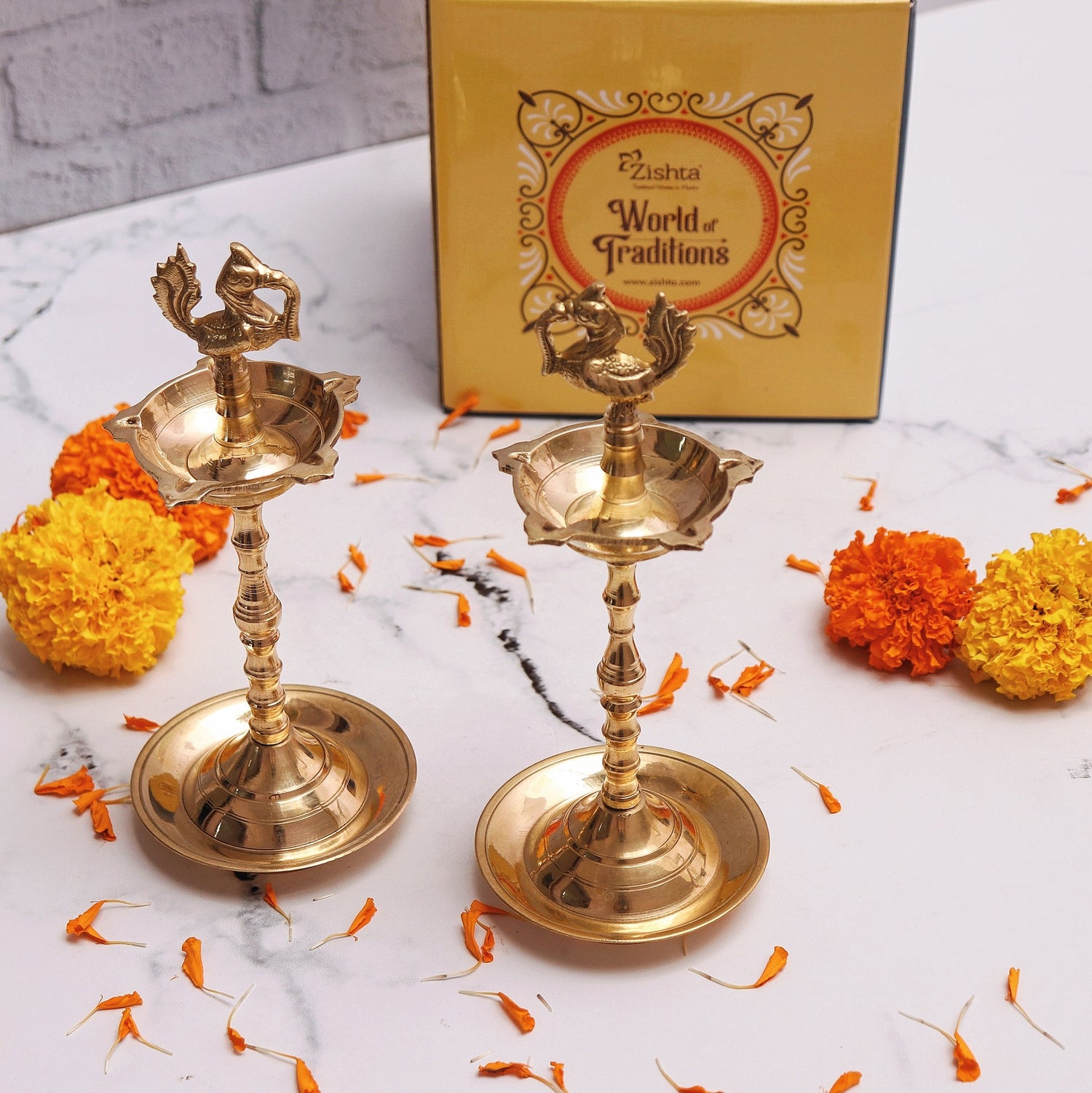Traditions have a strong connect with the community and provides a strong cultural significance. Lighting an oil lamp in the house is an integral part of our rich traditions across the country.
About the Craft and its Makers
The documented history of Kuthu Vilakku makers in Tamil Nadu dates back several centuries and is closely tied to the history of Hindu temple architecture and worship practices in the region.
Kuthu Vilakku have been used in Hindu temples and homes in Tamil Nadu for centuries as a source of light during religious ceremonies and rituals. The tradition of making these traditional oil lamps has been passed down from generation to generation, with each new generation adding their own unique designs and techniques to the craft.
In the past, Kuthu Vilakku were made by a caste of metalworkers known as the "Streevakya community," who were skilled in the craft of metalworking and were responsible for creating various metal objects for Hindu temples. These metalworkers lived and worked near the temples, and their skills and knowledge of metalworking were passed down from father to son.
Over time, as demand for Kuthu Vilakku grew, the craft became more widespread, and metalworkers from other communities also began making these lamps. Today, Kuthu Vilakku are made by a variety of metalworkers in Tamil Nadu, and the tradition continues to thrive.
In recent years, the tradition of making Kuthu Vilakku has gained recognition as an important aspect of Tamil Nadu's cultural heritage, and many organizations and individuals have worked to preserve and promote the craft. As a result, Kuthu Vilakku continue to be a popular and iconic symbol of Hindu culture in Tamil Nadu.
Agama Shastras and its rules in making the Kuthu Vilakku
Agama Shastra is a collection of Hindu scriptures that are believed to have been recorded between the 2nd century BCE and the 8th century CE. However, the exact dates of when each text was written are not known, and some of the texts in the Agama Shastra corpus are thought to have been composed at different times and by different authors.
Agama Shastra is a collection of Hindu scriptures that provide guidelines for temple architecture, iconography, rituals, and worship practices. Regarding the making of traditional oil lamps, Agama Shastra provides specific instructions on the design, size, and materials used for oil lamps used in Hindu temples.
According to Agama Shastra, traditional oil lamps should be made of metal, typically brass or bronze, and should be shaped in specific ways that are considered auspicious and symbolically significant. For example, the lamp's stem should be shaped in a certain way, and the lamp's base should have certain decorative motifs that are said to bring good luck and protection.
In addition, Agama Shastra provides detailed instructions on how the oil lamps should be lit and how the wicks should be trimmed. The lighting of the lamps is considered a sacred act and is performed as part of daily worship rituals in Hindu temples.
In summary, Agama Shastra provides comprehensive guidelines for the making of traditional oil lamps and the rituals associated with their use in Hindu worship. The oil lamp is considered a symbol of light and knowledge, and the guidelines provided in Agama Shastra help to preserve the traditional cultural and spiritual significance of these lamps.
How are Traditional Lamps (Kuthu Vilakku) made
The following is a general overview of the process of making Kuthu vilakku:
- Molding: The first step in making Kuthu vilakku is to create a mold for the lamp. This mold is usually made of clay and is used to shape the base and stem of the lamp.
- Casting: Once the mold has been made, molten metal, typically brass or bronze, is poured into the mold. The metal cools and solidifies, taking the shape of the mold.
- Shaping: The solid metal base and stem are then removed from the mold and shaped further to refine the details of the lamp.
- Polishing: The metal base and stem are then polished to give them a smooth and shiny finish.
- Assembling: The base and stem are then assembled to form the lamp, and a wick is inserted into the top of the lamp.
- Finishing: Finally, decorative details such as engravings or etchings are added to the lamp to give it a traditional look.
The process of making Kuthu vilakku can vary slightly depending on the specific style and design of the lamp, but the basic steps outlined above remain the same. Kuthu vilakku are an important part of Tamil Nadu's cultural heritage and are widely used in traditional Hindu ceremonies and festivals.
The most traditional designs of Kuthu Vilakku
-
Annam Vilakku: The annapakshi (Swan) bird at the top is the most traditional design of these lamps. As per Agamashastra these can be made from small tabletop lamps to sizes greater than 7-10 feet. The shape and size depend on purpose of its usage. General home usage, the range varies between 1 feet to 2.5 feet. These designs come with either 5 wicks or 7 wicks (rare usage as per Shastra)

-
Ega Vilakku: Ega Vilakku, also known as Naga Vilakku, is a traditional oil lamp used in Hindu religious ceremonies and rituals, especially in South India. The exact history of Ega Vilakku is not well documented, but they are believed to have been used for thousands of years in Hindu temples and homes in India.

- Porai Vilakku: This is a unique design as well which comes with only 4 wicks instead of the standard 5 wicks. This design is more prevalent in southern part of Tamil Nadu.
How to Clean and Maintain the Traditional Lamps:
Maintaining a traditional Kuthu Vilakku is relatively simple and straightforward. Here are some tips to help keep your Kuthu Vilakku in good condition:
- Clean regularly: Wipe the lamp down with a soft, damp cloth to remove any dirt or debris that may have accumulated on its surface. This will help to prevent the metal from oxidizing and will keep the lamp looking shiny and new.
- Store properly: When not in use, store the Kuthu Vilakku in a dry, cool place. Avoid storing it in damp or humid environments, as this can cause the metal to rust or corrode.
- Handle with care: Avoid handling the Kuthu Vilakku roughly, as this can cause scratches or other damage to the metal surface. When lighting the lamp, be careful not to over-tighten the wick, as this can cause the metal to deform.
- Use the right oil: Use only pure, high-quality oil in your Kuthu Vilakku. Avoid using low-quality oils that may contain impurities, as this can cause the wick to smoke or the metal to tarnish.
- Regular maintenance: If the wick needs to be replaced, use only high-quality cotton wicks. Additionally, you may want to periodically polish the metal surface to keep it shiny and bright.
- Please scrub the surface with tamarind or lime while cleaning to bring back the shine. Other options is to dismantle the parts and soak it in water with tamarind or lime skins and after 40 mins wash them well and wipe it dry. Even use of Ash helps in the cleaning process.
By following these simple tips, you can keep your Kuthu Vilakku in good condition for many years to come and enjoy its beautiful and timeless design for years to come.
Factors to consider before Purchasing a Good Traditional Lamp:
When purchasing a traditional oil lamp, such as a Kuthu Vilakku or Porai Vilakku, there are several factors to consider to ensure that you are getting a high-quality product:
- Material: Make sure the lamp is made from a high-quality metal, such as brass or bronze, that is known for its durability and resistance to corrosion. Avoid lamps made from low-quality metals that may rust or deteriorate over time.
- Craftsmanship: Look for lamps that are well-made and have a solid, heavy feel to them. Make sure the metal is polished to a high shine and that there are no rough edges or deformities.
- Size and design: Consider the size and design of the lamp, as well as its intended use. Make sure the lamp is appropriately sized for its intended use and that it has a design that is aesthetically pleasing to you.
- Price: While traditional oil lamps can be expensive, it is important to remember that you often get what you pay for. Consider the price of the lamp in relation to its quality and materials.
- Reputation of the seller: Consider purchasing from a reputable seller with a proven track record of providing high-quality traditional oil lamps. Look for sellers who specialize in traditional crafts and who have a strong reputation for quality and customer satisfaction.
By considering these factors, you purchase a high-quality traditional kuthu vilakku and Illuminate your Home with the Beauty of Traditional Lamps.




2 comments
Kiran Jakhar
🙌
Vivan
Please send me the details and price of the product
Leave a comment
All comments are moderated before being published.
This site is protected by reCAPTCHA and the Google Privacy Policy and Terms of Service apply.